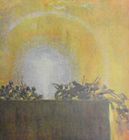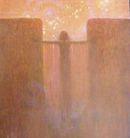Fritz Hass
Fritz Hass (born October 29, 1864 in Heiligenbeil , † October 20, 1930 in Lugano ) was a German painter , illustrator , caricaturist and photographer .
Life
The son of the Protestant pastor Rudolf Otto Theodor Hass studied after a brief stay at the Königsberg Academy from 1885 to 1889 at the Art Academy in Munich . After completing his studies, he settled there, continued his self- didactic training and from then on worked as a freelance artist and owner of a painting and drawing school for women of the better classes .
In 1892, the year the Munich Secession was founded, he first became known to a larger public through the exhibition of his painting Tot . In the following years he was represented at exhibitions of the Secession with the paintings The Night , The Great Babylon , Evening Tales and various portraits, such as the portrait of Max Halbe .
In 1894 he made a name for himself as a caricaturist with the publication of a cycle of eleven humorous pen and ink drawings under the title Satirischer Zeitspiegel . From 1895 he worked for the Meggendorfer-Blätter and contributed to the magazines Jugend and Kikeriki . The popular postcard pictures in which he characterized local mountains with human faces also came from his hand. He published picture books, illustrated eleven Schubert songs and recorded the destruction in the sites of his homeland East Prussia as a result of the First World War in paintings.
Under the influence of Rudolf Steiner , whom he portrayed and also photographed, he increasingly dealt with biblical and mythological themes in his painting . In a creative phase that lasted over a quarter of a century, he worked completely withdrawn and on the verge of subsistence. The works he created during this time, which were first presented at a special exhibition in the spring of 1922, attempt to dissolve the representational by means of color effects and to make mental states or the inexpressible essentials of things visible. With its dissolution of forms and its claim to depict reality in its essence, hatred stands between symbolism and surrealism . His paintings have been called painted philosophy . Fritz Hass likes to be with his son of the same name, Fritz Hass jun. (1902–1994), who also worked as a painter in Munich until his death.
criticism
“The symbolist Haß is stylistically related - in his use of pastel tones, for example - to the impressionist , secessionist Munichers like the early Franz von Stuck . Other images (The Milky Way, Sanctus, Lichtbringer, Golgotha) document, like a portrait of Steiner, the proximity to the Christian ( Adyar ) theosophy . Hatred was one of those who wanted the "spiritual" to be represented in art, and contemporaries also assigned the impressionistic style of painting, which dissolves contours and objects, to this goal.
Works (selection)
Illustrations
- 1897 The smoking coupé
- 1902 Erlkönig , Serenade , Wanderer's Night Song , Death and the Maiden , The Trout
- 1907 in the beer garden
- 1908 At the bowling alley
painting
- 1892 dead
- 1894 The night
- 1895 The great Babylon
- 1907 Boy in bed and girl at the table
- 1915 The destroyed Elk
- 1920 Bringer of light
- 1920 The Milky Way
- 1921 Archangel
Portraits
- 1895 Max Halbe
- 1911 Rudolf Steiner
- 1919 self-portrait
- The young artist (portrait of his grandson Hermann)
Publications
- Schubert-Lieder , Ten Drawings, Munich 1902.
- Moon and Stars , Munich 1913, [Dietrich Munich artist picture books, 23].
- German Heimatbilder Munich 1914.
- From East Prussia: Memories of the Great War. 10 colored artist postcards based on original paintings , Munich 1916.
- Picture folder (content: 1. Golgotha - 2. The Soul of the World - 3. Fall of Darkness - 4. The Guardian - 5. The Bringer of Light - 6. Archangel - 7. Sanctus ), ed. by Michael Georg Conrad , Munich 1922.
literature
- Spiritual Germany at the end of the 19th century Century. Encyclopedia of German intellectual life in biographical sketches. Volume 1: Visual Artists. Leipzig 1898.
- Hatred, Fritz . In: Hans Vollmer (Hrsg.): General lexicon of fine artists from antiquity to the present . Founded by Ulrich Thieme and Felix Becker . tape 16 : Hansen – Heubach . EA Seemann, Leipzig 1923, p. 107 .
- Wilhelm Matthießen : Fritz Haß. In: Westermannsmonthshefte . Illustrated magazine for the German house. Year 69, issue 11, Braunschweig 1924, p. 21ff.
- Hatred, Fritz . In: Hans Vollmer (Hrsg.): General Lexicon of Fine Artists of the XX. Century. tape 2 : E-J . EA Seemann, Leipzig 1955, p. 387 .
- Ludwig Hollweck : caricatures. From the flying leaves to the simplicissimus. Herrsching 1981.
- Kurt Flemig : Caricaturist Lexicon. Munich, London and others, 1993.
Web links
- Literature by and about Fritz Hass in the catalog of the German National Library
- Entry in the register book of the Art Academy Munich
- Auction results Fritz Hass on arcadia.com
- Caricatures by Fritz Hass on artefact.com
Individual evidence
- ↑ Source: autobiography, printed in: Das Geistige Deutschland des XIX. Century. Volume 1 1898; other sources give October 20th as the date of birth
- ↑ The well-known portrait photo that shows Steiner during a vision comes from Fritz Hass.
- ^ Helmut Zander: Anthroposophy in Germany. Volume 2, Göttingen 2007, p. 1070.
| personal data | |
|---|---|
| SURNAME | Hatred, Fritz |
| ALTERNATIVE NAMES | Haß, Fritz (different spelling) |
| BRIEF DESCRIPTION | German painter, illustrator, caricaturist, photographer |
| DATE OF BIRTH | October 29, 1864 |
| PLACE OF BIRTH | Holy ax |
| DATE OF DEATH | October 20, 1930 |
| Place of death | Lugano |














